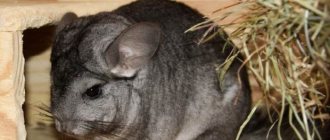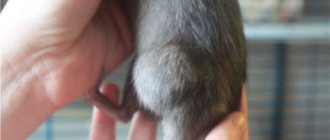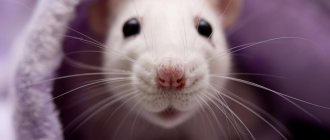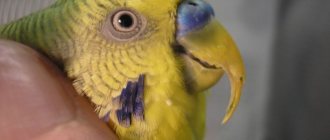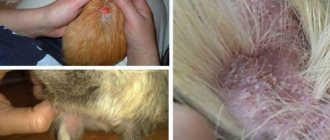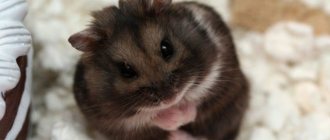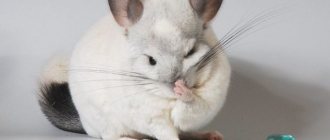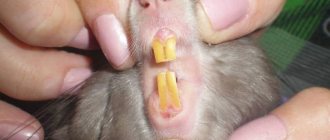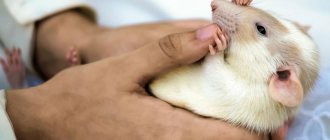Today, many lovers of furry pets have a chinchilla in their home - a cute and quite active animal. This attractive animal has not only amazing beauty, but also a cheerful, friendly character. In addition, the chinchilla is very unpretentious in maintenance. According to many people, its unusually thick fur serves not only as an decoration for the animal, but also as an obstacle to the appearance of blood-sucking insects. This article will tell you whether chinchillas really have fleas.
Do chinchillas have fleas?
Chinchillas are friendly, undemanding pets.
Animals get sick a little and do not need special care. However, chinchillas sometimes have fleas. For their owners, this information often comes as a surprise. After all, animals are kept in comfortable, homely conditions and do not leave their home.
Also, many believe that chinchillas do not have fleas because rodents have thick fur and bathe in sand. Indeed, animals do not have their own parasites. But pests can be brought in from the street by cats or dogs.
Other routes of infection:
- fleas enter the house by clinging to people's shoes or clothing.
- Attics or basements are favorite habitats for blood-sucking insects. Through cracks and small openings, parasites easily enter a person’s home.
- Sometimes an animal may already be infested with fleas, for example, in a pet store.
- Parasites are often found in hay that is placed in a rodent's cage.
After landing on the body of the intended host, the insects find places where there is the least amount of hair. These are ears, muzzle or paws.
Conjunctivitis
Poor maintenance can cause animals' eyes to become clogged with dust or irritated by mold spores. Conjunctivitis can be either mechanical or infectious. With mechanical damage, a speck of dust gets into the eye and the animal’s tears begin to flow.
Interesting! Tears are a protective mechanism against mechanical irritants of the eyes.
What to do if your chinchilla's eyes are watery:
- check for debris under the eyelids;
- rinse eyes with saline solution;
- apply antibiotic drops.
If there are no specks, but your eyes continue to water, this is most likely the beginning of an infectious disease. In this case, it is better to go to the veterinarian to find out the reasons, while the inflammation is still weak and the eye has not festered.
A more severe form of conjunctivitis is purulent.
Very often this is a sign of a general infectious disease resulting from hypothermia and weakened immunity. Local diseases caused by pathogenic microorganisms include inflammation of the lacrimal canal. This disease is usually closely related to the malposition of molars. If an animal constantly develops hooks on its back teeth, you must be prepared that sooner or later the tear duct will also be blocked.
What to do if a chinchilla’s eye festers:
- Before examining the veterinarian, carefully wipe the animal’s eyes with a decoction of calendula, chamomile or other suitable infusion;
- go to the veterinary clinic to determine the cause of the disease;
- follow your doctor's recommendations.
Self-medication here can only do harm, since in case of a general illness it is not the symptoms that need to be treated, but the cause. And if the tear duct is clogged, it will be difficult for the chinchilla breeder to clear it due to the small size of the animal. In addition, tooth extraction may be required.
Checking your chinchilla for fleas
Fleas prefer warm, moist places to live, ideally the fur of warm-blooded animals. This applies to the most common types of parasites - cat and dog bloodsuckers, which are no different from each other in their lifestyle. At the same time, they lay eggs on litter and other warm, hidden places. Having brought a playful, affectionate animal into your home, immediately carry out a preventative examination. Especially if he itches and bites the skin. Blood-sucking insects prefer to live on the legs and ears, since there is less fur there compared to the body. If there are no fleas, the skin is clean, smooth, without ulcers or scratches. If the above signs are found, this indicates the presence of parasites.
Important! The assumption that chinchillas do not have fleas is wrong. Their fur is thick and their love of swimming in the sand is considered a good prevention of their appearance. However, if there are insects in the apartment, chinchilla infection is inevitable!
Liver and kidney diseases
Kidney and liver diseases are no less common than others in the life of chinchillas. Jaundice, liver dysfunction, cystitis and urolithiasis seriously complicate their existence, so it is advisable to identify the specific ailment as quickly as possible and begin appropriate treatment.
Jaundice
This disease is usually a consequence of inflammatory processes or other diseases of the chinchilla’s liver.
You can suspect its presence based on the following characteristic signs:
- yellowing of the whites of the eyes;
- yellowing of mucous membranes;
- yellowing of chinchilla fat, due to the inability to process carotene and vitamin A.
Liver disorders
The appearance of this pathology can be explained by an excess of fats and proteins in the diet of chinchillas.
Specific symptoms depend on the root cause and the nature of certain disorders, but they are almost always:
- lethargy and apathy;
- depressed appearance;
- lack of shine and healthy appearance of the coat;
- refusal to eat (typical for severe forms of the disease).
Did you know? The natural color of chinchillas is gray, and this is how they are found in the wild. All other shades were obtained during long-term selection work, and their owners are characterized by less good health.
Tocopherol, which is also present in some foods, is often prescribed to treat the liver of chinchillas. Thus, regularly giving the animal peas, oats or alfalfa is a good preventive measure for the development of almost any liver problem.
Of course, in addition to these, it is equally important to comply with animal feeding requirements
Cystitis
Inflammation of the bladder (cystitis) in most cases is a consequence of hypothermia of the animal due to a sharp drop in temperature or the appearance of drafts in the room.
The main symptoms of cystitis are:
- restless chinchilla behavior;
- frequent urge to urinate;
- a small amount of urine, sometimes mixed with blood.
If there are no positive results within three days, it can be assumed that there are stones in the kidneys, but only a doctor can confirm or refute this assumption.
Urolithiasis disease
Urolithiasis in chinchillas often causes hemorrhagic cystitis, but it usually affects adults, mainly males.
Symptoms of urolithiasis:
- urge to urinate and retention;
- restless and sometimes aggressive behavior of the animal;
- the appearance of blood in a small amount of emitted urine.
Treatment of urolithiasis depends on the results of a complete examination. If only sand is found in the kidneys, then drug therapy can help the chinchilla (the antibiotic Baytril + probiotics is often prescribed), while stones cannot be eliminated without surgery. If you do not seek medical help in a timely manner, the possibility of death cannot be ruled out.
How fleas get into an apartment
If you are interested in the question of why your chinchilla itches and bites itself, check it for fleas, even if it is the only animal in the house. After all, bloodsuckers can get into a city apartment or private house in several ways:
- flea larvae or young, active insects can be carried on clothes and shoes;
- through ventilation shafts, openings;
- with sand and food, even purchased in a store;
- and the most common option is with pets who prefer warm, damp places for walking - basements, attics, sheds.
Important! If fleas are detected, you should start fighting immediately, because one mature individual lays a large number of eggs per day, which, under favorable conditions, turn into an adult insect within a few days.
Reviews
- Chinchillas have fleas, especially if there are other animals at home - dogs and cats. My Polya itched and behaved restlessly until I completely disinfected the apartment, cage and all pets. The chinchilla has become playful and cheerful again!
- I used to think that chinchillas don’t have fleas - their fur is too thick. But, recently a veterinarian pointed out their presence and suggested how to deal with it. I was very surprised, because there are no more animals in my house. But often children take her to the dacha, where most likely she became infected with parasites.
- When we got a chinchilla, we didn’t even think about the possibility of flea infestation. We didn’t have them in our house, nor did our cat, which I regularly treat against parasites. But, after a while, I discovered that the new member of the household was itching a lot and biting himself. I looked, parting the pile of thick fur - and there were a great many of them! Conducted a complete disinfection of the house, furniture, cats and rodents. A single treatment was enough to get rid of insects
Watch a video about treating rodents for fleas:
Source
How do chinchillas get fleas?
Can a chinchilla get fleas if it is always in a cage and not in contact with other animals? This question worries many owners of cute animals. In fact, bloodsuckers can settle on the thick skin of the animal:
- jumping over other pets;
- coming from attics, basements;
- from sand or hay, which are used for bathing, animal bedding;
- from carpets, upholstered furniture and other items in the house, if the room was infested with fleas even before the animal appeared;
- having settled on an animal in a pet store or market.
Important! Dogs and cats are the main sources of the spread of blood-sucking insects, especially if they are outdoors. Flea collars are not a 100% guarantee of sterility!
Prevention
To avoid having to remove fleas from chinchillas, it is important to provide the animals with proper care and maintenance. Preventive measures involve regular cleaning of the rodent cage using special products.
If other pets live in the house with the chinchilla, then it is important to periodically inspect them for fleas and, if necessary, treat their fur with insecticides.
You also need to do a thorough cleaning of the entire house every 2-3 months.
And if there are fleas in the basement, living rooms or attic, then measures should be taken immediately to destroy them.
What to do if your chinchilla has fleas
Do not worry. This is a serious problem, but completely solvable. You need to go to the pharmacy and buy an anti-flea collar for kittens or small dogs. The use of drops such as “Bars”, “Stronghold” is fraught with poisoning : the rapid metabolism characteristic of rodents makes chinchillas very vulnerable to various chemicals.
Under no circumstances should you use anti-flea shampoos. In nature, chinchillas live in deserts and almost never encounter enough water to wet their fur. Bathing is a serious stress . In addition, the risk of catching a cold .
After putting a collar of a suitable size on the animal, you should proceed to measures aimed at exterminating fleas and their larvae in the home.
- Wash the chinchilla's cage with a solution of tar soap and vinegar.
- Change the sand in the sand bath.
- If there are other animals in the house, treat them for fleas too.
Carefully . If you remove the collar from the animal too early, it may become infected with fleas again. This happens for the reason that the parasite eggs, once on the floor, turn into larvae, which after 7-10 days give rise to a new generation of bloodsuckers.
To avoid re-infection , thoroughly wash the floors with a special product from a veterinary pharmacy. The floor treatment will need to be repeated after 1-2 weeks to destroy the newly hatched larvae and prevent them from pupating and laying eggs.
Do I need to rinse my eyes?
Of course it is necessary. Another question - with what?
Quite often, owners use decoctions of medicinal herbs to wash their pets - strong tea, chamomile or calendula decoction. Veterinarians do not advise doing this for a number of reasons: they dry out the mucous membrane, it is impossible to maintain the normal concentration of the solution, such decoctions quickly become unusable, becoming a source of secondary bacterial infection.
To wash the eyes of a chinchilla, it is advisable to use special lotions - Lakrimin, Lakrikan, Ofto-lavas.
In the absence of special means, you can wash your chinchilla’s eyes with simple freshly boiled and cooled water or sterile saline solution.
Inspection rules
To understand whether there is a problem, you need to examine your pet's paws and ears. In these places, the fur is sparse and the skin is thin. Sometimes parasites settle on the stomach and head. A flea can live on a chinchilla's back, but this area is the last area to become infected.
It is extremely rare to see parasites through fur. In the event of any threat, insects quickly hide in thick fur, so a person does not have time to notice them. However, brown feces and flea eggs can be seen on light-colored fur. The latter look like small dark grains.
You can understand that a chinchilla is infected by the following indirect signs:
- Itching. Appears in the early stages of a pet. It disturbs the animal even during sleep.
- Bites. Marks appear on the skin that can be confused with rashes.
- Deterioration in appearance. With severe infection, the body becomes depleted. The chinchilla is losing weight and losing hair.
- Anemia. With the development of anemia, the mucous membranes become pale.
Chinchillas have quite thick fur and it is very difficult to see the insect during inspection.
Features of feeding treats
Often, the desire to pamper a chinchilla forces inexperienced owners to literally feed the animal with various treats. However, your pet’s consumption of treats must be kept under control, adhering to the following rules:
- Don't feed your chinchilla treats too often. The optimal frequency is 3-4 times a week. Eating treats more frequently will inevitably lead to obesity in your chinchilla. And as a result - to increased cholesterol, the development of heart and vascular diseases, heart attacks and strokes.
- It is advisable to offer all treats to your pet in a dried form. First of all, this concerns young animals with an unformed digestive system. Fresh fruits and vegetables can cause gastrointestinal disorders in the younger generation.
- You should feed your pet treats only after the main meal. Otherwise, over time, the fluffy will refuse regular food in favor of treats. The volume of one serving of treats should not exceed 10-12 g.
Also, some experienced chinchilla breeders recommend combining feeding with treats with training. Because the animal will learn commands much faster when reinforced with something tasty.
How do symptoms appear?
The most obvious symptom is a sudden change in behavior. In the early stages, your chinchilla may become overly active. She runs around the cage restlessly and scratches herself. Irritability increases and aggression may appear. Later, due to poor sleep, the rodent becomes lethargic. His daily routine is disrupted. In severe cases, the pet develops apathy. He reacts poorly to attention, food and games.
Bites appear on the animal's skin. They may resemble rashes or warts. If an allergy to flea saliva develops, additional symptoms may develop. The chinchilla may experience discharge from the eyes, sneezing, etc.
Hair loss in an animal may indicate the presence of fleas.
Diseases of the genitourinary system and mammary glands
Endometritis
Symptoms
- Lethargy
- Loss of balance
- Collapse
- Dull coat
- No appetite
Treatment
Baytril 0.1 ml and Gamavit 0.7 ml. Subcutaneously 1 time per day. The course of treatment is 7 days.
Then Mastomethrin 0.3 ml and Ovariovit 0.3 ml subcutaneously. The course of treatment is 7 days.
Prevention
Avoid exposure to sun, washing in water, loud noises, rough handling. Do not give dairy products, sweets, eggs, meat or fast food. Do not take the animal outside.
Mastitis
Symptoms
- Breast enlargement
- Restless behavior
Treatment
It's best to see a veterinarian first to make sure there are no abscesses.
Mastometrin injections 1 ml per day, Warming, Massage
Prevention
Prevention here is very difficult to achieve. The cubs can bite the female and damage the mammary glands, resulting in mastitis. The only thing the owner can do is not to abruptly separate the babies from their mother and breastfeeding.
Urolithiasis disease
Symptoms
- Anxiety
- Redness in urine
- Refusal to eat
Treatment
Prevention
This disease can be caused by improper living conditions, stale food or frequent colds. Therefore, the animal must have plenty of water, a suitable cage and food.
Cystitis
Symptoms
- Nervousness
- Frequent urination
- Redness in urine
Treatment
Trimethoprim 20 g 2 times a day and sulfamethoxazole 100 mg 2 times a day.
Prevention
Avoid hypothermia, severe temperature changes, and drafts
Carry out preventative treatment of your home on time
How to remove fleas from a chinchilla
Veterinarians and owners of furry rodents who have encountered a similar problem know what to do if a chinchilla has fleas. Removal of blood-sucking insects consists of two stages. First, the animal and its cage are disinfested.
Further, if necessary, measures are taken that involve the use of antiparasitic agents.
To get rid of fleas forever, you need to disinfect the entire house. For treatment, you can use special insecticidal or folk remedies.
Other important detoxification activities:
- washing of all bedding and rugs.
- Treating other domestic animals with insecticides.
- Applying antiparasitic agents to all secluded places (floor, baseboards, furniture).
During detoxification procedures, it is necessary to remove animals and people from the home. Several hours after treatment, ventilate the premises, wash floors, surfaces or vacuum them.
For the complete disappearance of fleas, repeated antiparasitic measures are recommended.
Processing the cage and animal
To get rid of pests forever, it is not enough to know how to remove fleas from a chinchilla. For the absolute destruction of insects, the use of insecticides or collars is not enough.
To prevent pests from appearing in your pet again, you need to thoroughly clean the animal’s cage.
For this purpose, the following activities are carried out:
- Sweep out all the trash (droppings, crumbs, leftover food).
- Change hay and sand.
- Treat the cage with a mixture of tar soap and vinegar.
- Boil the litter and disinfect it.
After treatment, it is advisable to place the chinchilla cage in the open air for 2-3 hours. Moreover, it is advisable to place it under the sun's rays.
Antiparasitic agents
After disinfecting the apartment and cage, it is necessary to take the animal to the veterinarian for examination. The doctor will examine the animal and then advise how to rid the chinchilla of fleas.
Often, if parasites are present, the doctor prescribes drops or sprays. Frontline is considered an effective remedy for blood-sucking pests. The drug is produced in the form of a spray or drops, which are used in a minimal dosage.
Other popular flea treatments for chinchillas:
- Advantage (drops);
- Fogger (spray);
- Lawyer (drops);
- Canina Bio (biospray);
- Le Artis (spray);
- Bars (spray);
- Palladium (spray);
- Butoxept (spray).
The chinchilla is a small animal that is very sensitive to chemicals. Therefore, the use of toxic agents in large doses can cause intoxication in a rodent.
The dosage of any antiparasitic agents should be minimal. Veterinarians recommend using doses intended for kittens or puppies.
For those who do not want to take risks in order to prevent rodent poisoning, doctors recommend that they refrain from using chemical antiparasitic drugs. You can simply put a collar on the rodent. It will not harm the chinchilla, as it is considered a less toxic product.
Also, veterinarians do not recommend using pest control shampoos.
After all, the natural habitat of chinchillas is the desert. Rodents never wash themselves. Moreover, water can accumulate in the animal’s dense fur. This will increase the likelihood of your pet getting a cold.
Video
How to remove a chinchilla cage.
Fighting bloodsuckers
The following symptoms indicate that the rodent has been attacked by fleas:
- the chinchilla is nervous and itches all the time;
- scratches are visible on the skin;
- formations resembling warts grow at the bite sites;
- if you part the hair, you can see parasite excrement, similar to black dots;
- with severe lesions, baldness appears in some places.
Although thick hair partly protects the chinchilla from parasites, where it is sparse, fleas are visible.
Animals cannot be treated with medications for cats and dogs. Due to the small size of rodents, the doses of pesticides contained in these substances cause poisoning. In addition, chinchillas are sensitive to chemical compounds. Therefore, you should not take risks and treat them with sprays, powders and drops.
Anti-flea collars that are placed on animals will help get rid of parasites. For chinchillas, models for cats and small dogs are suitable. The amount of pesticides they contain will not harm rodents.
To completely get rid of insects, the entire apartment is treated with insecticide. Before putting a collar on the animal, take the following measures:
- wash with flea shampoos and treat pets with sprays;
- wash or replace their bedding;
- Thoroughly clean and rinse the rodent cage, replace the bedding and add fresh sand;
- In the apartment, the floors are washed, carpets, baseboards and upholstered furniture are treated with aerosols or insecticidal powder is scattered.
During processing, animals are removed so that they are not poisoned by pesticides. The parasites disappear after one or two such procedures.
Fleas are dangerous for chinchillas and the people and animals living with them. To get rid of bloodsuckers, treat the apartment with insecticides and put flea collars on the animals. For prevention, pets are regularly treated for fleas and hay intended for chinchillas is carefully inspected.
The main parasites of chinchillas
There are several types of ectoparasites that are found in chinchillas.
Fleas
These wingless insects jump high and cling to animal fur with their claws and bristles. The flea's body length ranges from 1 to 5 mm, and its mouthparts are designed to pierce the host's skin and feed on blood. They carry pathogens of dangerous diseases such as typhoid, plague, and hepatitis.
Chinchillas can become victims of cat, rabbit and rat parasites. When infected with fleas, the animal itches, hair falls out, and bites resembling warts appear near the face and on the limbs. Insects can be detected by parting the fur.
Lice and lice eaters
Both types of parasites live in the fur of mammals; the sizes of individuals vary from 0.5 to 10 mm. Lice feed on blood, and lice eaters feed on blood and skin particles. They reproduce quickly, laying white eggs - nits that stick tightly to the hair.
These insects also carry infections that are dangerous to people and pets. Their bites cause severe itching and anxiety in animals, as well as scratching on the skin.
Ticks
Chinchillas are parasitized by subcutaneous and ear mites that live in the upper layer of the epidermis. Because of them, bumps, peeling and crusts appear on the skin, the animal often itches and experiences severe discomfort.
The diagnosis is made after microscopic examination of the scraping. Curing a pet from ticks is quite difficult and is often possible only in the initial stages: first, the animal is cut, then washed in a 0.5% bromocyclene solution 4 times at intervals of 8 days.
Skin diseases
Dermatophytoses: ringworm, fungus
Varieties of the disease are accompanied by partial hair loss, especially in the area of the nose, tail and ears. It is not difficult to cure the disease in the initial stages.
If an unhealthy animal does not live alone in the apartment, then it is important to move it away from others, since dermatophytoses are a contagious disease. It is worth lubricating the affected areas with Vakderm, Mycodermit or Grisiofulvin
The enclosure must be disinfected. For effective treatment, it is important to consult a veterinarian.
Gnawing fur
An animal can spoil the fur not only of itself, but also of other relatives. A bald spot appears at the site of the bite, the skin on which cracks and bleeds. The reason for this behavior is due to a metabolic failure. The disorder occurs as a result of a lack of phosphorus, vitamin D, fatty acids, and calcium.
It won't hurt to add a little lard to your pet's diet. To prevent the animal from getting dirty while eating, fatty pieces should be hung in the cage.
Alopecia - hair loss
It is impossible to name the exact cause of the disease. It is believed that this disease is caused by an unbalanced diet and inappropriate living conditions. A consultation with a veterinarian will help heal your pet.
Ectoparasites
Ticks, lice and fleas sometimes appear on domestic animals. After their attacks, the chinchilla chews out its own fur and tries to relieve the itching caused by the bites of annoying insects. A special collar will help remove parasites. This device serves its purpose much better than bathing or sprinkling with powder. It is definitely worth removing insects in a cage.
Ringworm or fungus in chinchillas
If your pet itches and bites itself, the cause may be a fungal skin disease - ringworm, or ringworm. Signs that distinguish the disease:
- hair loss in certain areas;
- peeling of the skin;
- formation of crusts and red spots;
- sometimes discharge of pus from wounds.
A chinchilla usually easily tolerates the disease, but if it is neglected, the animal can become completely bald, and the fungus can also affect other organs.
Diagnosis is carried out using an ultraviolet lamp in a dark room: with dermatomycosis, areas of the skin glow green. This test does not detect ringworm caused by some types of fungi; in such cases, skin and hair samples are taken for microbiological analysis.
Factors that increase the risk of disease:
- chronic stress;
- avitaminosis;
- malnutrition;
- high air humidity;
- poor hygiene;
- contact with the vector.
Ringworm is an unpleasant disease, but relatively easy to treat. Therapy is prescribed by a veterinarian; drugs such as clotrimazole, lamisil, exoderil, etc. are usually used. There is a vaccine against fungus that is administered to chinchilla puppies after 6 months.
Ringworm is easily transmitted to humans, so a sick animal should be isolated and touched only with gloves.
Respiratory diseases
This group of chinchilla ailments is often associated with improper animal care. For example, a typical cause of a runny nose is a common cold, and the basis for the development of pneumonia or bronchopneumonia can be a pet’s prolonged exposure to low temperatures.
Each ailment requires an individual treatment plan, and it is better if a doctor draws it up. The owner of the animal is only required to diagnose the problem in a timely manner and strictly follow all the veterinarian’s instructions.
Learn how to make a chinchilla display case and a wooden display house.
Runny nose
A runny nose can hardly be called a serious illness, but it can still cause both the chinchilla and its owner a lot of trouble. Most often, animals suffer from it in early spring or late autumn, during the so-called off-season period. It is not difficult to determine the occurrence of such a disease in your pet, because its symptoms are clearly visible externally.
These include:
- the appearance of white or yellowish mucus in the corners of the eyes;
- formation of clear or cloudy nasal discharge;
- the animal’s apathetic state and constant drowsiness;
- frequent breathing.
A runny nose is dangerous for a chinchilla, since the animal breathes only through its nose.
Prevention of a runny nose will include frequent ventilation of the room (of course, without creating drafts), wet cleaning of the room and maintaining optimal temperature conditions in it.
Did you know? Chinchillas do not shed, but can completely shed their fur in a stressful situation or if they are in danger.
Bronchopneumonia
An untreated runny nose and a mild cold may well develop into a more serious condition - bronchopneumonia.
The main symptoms of this disease are as follows:
- persistent cough;
- frequent and hoarse breathing;
- general weakness and apathy.
Pneumonia
This disease is more typical for newborn animals, especially if they were born in the autumn-winter period. Often the main cause of the disease is a secondary infection, the causative agents of which are streptococcus and staphylococcus, and the disease manifests itself with the following characteristic symptoms:
- increased temperature;
- difficulty breathing (wheezing and noises are heard);
- discharge from the nasal cavity.
Important! The drug "Baytril", which is often prescribed by veterinarians in such cases, is a fairly easy remedy and is not always able to cope with the disease. Moreover, at the same time it is necessary to give the chinchilla Lactobacterin or Vetom, diluted with water in a 1:1 ratio.
Hyperemia of the lungs
The main reason for hyperemia is a violation of the requirements for the conditions of keeping chinchillas. This problem often appears in the summer, when the animals spend a long time in a stuffy room, however, inhalation of toxic gases by a chinchilla can also provoke the development of the disease.
In any case, the main symptoms of the development of pulmonary hyperemia are:
- attacks of suffocation;
- hoarse cough;
- rapid heartbeat;
- the appearance of shortness of breath;
- reddish foamy nasal discharge (rare).
So, if we are talking about overheating, then you can pour cool water over the animal and give it heart drops containing caffeine and cordiamine. In addition, diuretics and laxatives will help normalize the chinchilla’s condition, and if complications develop, it will be useful to use sulfonamides and antibiotics.
Find out what to name a chinchilla.
How to treat
To reliably get rid of fleas, it is not enough to treat only the chinchilla. Insects can remain in bedding and furniture, so comprehensive measures need to be taken. They start by treating the cell. The chinchilla is temporarily placed in another place. It is better to change the litter completely, but if this is not possible, you can remove debris from the old one, boil it and treat it with a disinfectant solution.
The easiest option is to grind tar soap into shavings, dissolve it in water and add a little vinegar. The entire cage and accessories are also treated with the liquid. Sand and hay are changed.
Houses are vacuumed well, moving furniture away and paying attention to upholstery. Bedding is washed in boiling water to kill the fleas. You can do the same with cat and dog bedding if you have any in the house. If it was not possible to get rid of the parasites and the infection recurs, you will have to treat with an insecticidal solution.
The most accessible and simple remedy is Bars spray. You may have to go somewhere for a day and take your pets to avoid intoxication. Sprays are used to treat the bottoms of beds and sofas, mattresses, crevices behind baseboards and kitchen cabinets, etc. After 10 days, the procedure is repeated to destroy the hatched individuals.
Special antiparasitic agents are produced for chinchillas. Some owners use medications for cats and dogs, but the dosage of active substances in them is different. This may cause side effects. It is recommended to use drugs for rodents; in extreme cases, a minimum dose should be given.
As an alternative, you can purchase a collar for cats and dogs. It contains less active substances. It is not recommended to use flea shampoos, because... A chinchilla may catch a cold after bathing. If there are other animals in the house, they also need to be treated.
One of the options for protecting against fleas is to put a parasite collar on your chinchilla.
Skin diseases
Skin diseases of chinchillas are no less common than other varieties, and among the most characteristic are lichen, hair loss or self-gnawing by the animal, and parasite activity.
Ringworm
This fungal disease is one of the most contagious, so at the first sign of it, it is worth isolating the sick animal from healthy chinchillas.
Ringworm can be recognized by the following signs:
- hair loss around the animal’s nose and ears;
- bald patches in the tail area;
- almost complete baldness of the chinchilla, which is typical for the advanced stage of development of the disease.
One of the most popular drugs for internal administration, which has proven itself well in domestic veterinary practice, is Vakderm, which can be purchased at almost any pet store. Using an insulin syringe, the medicine is slowly injected into the femoral part of the animal (2 divisions each), and then after 1.5 weeks the procedure is repeated again.
Usually one ampoule is enough to vaccinate several animals, and the effect of the medicine lasts for a year.
Important! When performing an injection, secure the animal’s paw well and try not to hit the tendon. If the injection is performed incorrectly, the animal will limp. If you do not treat ringworm in chinchillas, then after a while it may go away on its own, but the appearance of the animal itself, other animals, and sometimes the owner himself may suffer.
If you do not treat lichen in chinchillas, then after a while it can go away on its own, but the appearance of the animal itself, other animals, and sometimes the owner himself may suffer.
Alopecia and hair loss
The exact cause of this phenomenon has not yet been determined, but many experts associate the sudden appearance of bald patches with non-compliance with the rules of keeping and feeding chinchillas, especially if such a problem is diagnosed in several animals at once.
The main symptom of alopecia is hair loss and its uneven growth throughout the animal’s body, although in some cases localized bald spots may appear.
It is interesting to know how long chinchillas live.
To normalize the chinchilla’s condition, it is recommended to review its diet and pay attention to the temperature and sanitary conditions of its keeping. When everything returns to normal, a new one will quickly grow in place of the lost hair.
Ectoparasites
Ectoparasites of chinchillas and other animals are usually called lice, fleas and ticks. They are the common cause of wool gnawing, because any animal will try to get rid of them.
You can suspect the appearance of parasites if:
- the animal constantly itches and bites something on the body;
- twitches his back;
- rubs against the cell walls.
Important! When dealing with your pet's parasites, be sure to pay due attention to its home. Fleas and lice can live in a cage for a long time, and as soon as you put the animal in it, it will again pick up unpleasant parasites
To get rid of ectoparasites, special collars are often used, sold in any pet pharmacy. Usually they are bought for cats and dogs, but in the case of a chinchilla they will not be superfluous. This is often a much more effective way to combat fleas and lice than bathing and treating the animal with a special powder.
To prevent chinchillas from ectoparasites, sand baths are used.
Gnawing fur
If there are definitely no parasites on the chinchilla’s body, but it continues to gnaw out whole clumps of fur on itself, it is likely that the animal has experienced serious stress (may be associated with transportation or sharing with another animal).
In this case, it is recommended to isolate the animal for a while and cover the cage with it with a dark cloth, providing it with complete peace. If after 5 days the pet stops chewing the fur, then with a high degree of probability we can say that it will grow back on the bald areas.
If your pet won't stop chewing fur, it may be lacking certain vitamins (eg A, E, D), phosphorus, calcium, potassium or methionine. Choose the most balanced food, provide a course of vitamins (can be dissolved in drink, or can be administered intramuscularly) or feed your pet with multivitamins. Mineral salt rock and hay should be kept in the cage at all times.
Treating a rodent for fleas
Only large-scale disinfection measures will allow you to get rid of fleas not only on the animal’s skin, but throughout the entire apartment. Immediately after detection, it is necessary to remove all inhabitants from the house and carry out disinfection with special preparations - spray or aerosol. You need to carefully treat the areas behind the baseboards, floor cracks, carpets, and upholstered furniture. After this, the apartment is thoroughly cleaned with washing and using a vacuum cleaner. All pets are also treated with insecticides and wearing flea collars.
Chinchillas have fleas, what not to do?
- Use anti-parasitic shampoos designed for larger pets.
- Bathing an animal, for which getting its fur wet can result not only in serious stress, but also a cold.
- Use chemicals such as Bars or Stronghold, which can cause poisoning.
Important! 1-2 treatments of the apartment will be enough for the insects to disappear!
Flea remedies
When using antiparasitic products intended for cats and dogs, it is worth keeping in mind that the chinchilla is much smaller in size than other pets. This means that the dose of the chemical must be reduced. Special sprays and drops can cause significant harm to the animal. Therefore, the best option would be a special collar that is used for cats and dogs. The product is less toxic compared to chemicals and safe for health.
Causes of infection
The chinchilla spends most of its time in a cage where there is special chinchilla sand for cleaning the skin, so there is no threat of infection from this side. But if there are other animals in the house that often go outside (dogs, cats, rabbits), then there is a risk of contracting parasites from them. Fleas easily move long distances and quickly sense the presence of warm-blooded animals, so they can easily get to chinchillas from other pets.
It happens that an animal enters the house already infected, so when purchasing an animal, carefully inspect it.
Another source of infection may be hay, which is a favorite treat for animals, purchased from an untrusted place. It can easily contain fleas. You should inspect it carefully before placing it in a cage.
Fleas that attack chinchillas are small, about 3 mm in length, but very jumping. They easily cover long distances and can live without food for a long time. Warm and humid rooms provide ideal conditions for their reproduction; they lay eggs in floor cracks and behind baseboards. Therefore, if parasites are found in the apartment, it is necessary to immediately carry out sanitary treatment in order to ensure that they get rid of them.
Preventive examination
As soon as the animal gets into your home, carefully examine its paws and ears. The fur on these parts of the animal’s body is much less dense than on the body, and parasites prefer to feed there. The skin is clean, no ulcers or scratches found, no insects? Everything is fine. Your animal is healthy.
You can tell that a chinchilla has fleas by indirect signs:
- The chinchilla experiences constant itching and cannot sleep peacefully. Losing weight.
- Dermatitis appears on the skin.
- The fur is falling off.
- Black specks are visible in the fur - flea droppings.
- Anemia occurs - the nose, gums and other mucous membranes turn pale, the animal weakens.
Attention. Many believe that chinchillas do not have fleas, since the thickness of their fur and love for swimming in fine sand prevent parasites from settling in their fur coat. But it is not so. They do not have their own parasites, but cat and dog fleas brought in from the street do not bypass any potential hosts.
Reviews
Chinchillas can have fleas. I verified this personally when I brought my pet to the veterinarian. He advised me to purchase a flea collar. Now my pet is cheerful, playful and doesn’t itch at all.
In the summer we often had to go to the dacha, and we took our chinchilla with us. Although there were no other animals nearby, she somehow managed to pick up parasites. After which it began to itch very much. My wife saw the fleas in the cage when she was cleaning it. They took the animal to the veterinarian, where they dropped something on her neck, and that’s it - there were no more problems.
I never knew that chinchillas have fleas. An acquaintance convinced me that insects could not breed in such thick fur.
Source
Can a person become infected from a sick animal?
Humans can only become infected by fleas of the species Pulex irritans. Therefore, there is a chance of becoming infected with parasites, but it is very small. You may also simply be a carrier of these insects. But you should still be careful, as the flea can carry plague and rabies. Therefore, it is important to regularly carry out preventive measures.
Sources
- https://parazitdoma.ru/blohi/u-shinshilly-chto-delat
- https://klopkan.ru/blohi/vsyo-o-blohah/byvayut-li-blohi-u-shinshill/
- https://hlopklop.com/blohi/blohi-u-shinshill.html
- https://lifeinsect.ru/blohi-u-shinshilly.html
- https://homjakam.ru/shinshilla/zdorovie/cheshetsya-ili-pokusyvaet-sebya
- https://combat-dez.ru/prichiny-i-simptomy-poiavleniia-bloh-y-shinshill/
- https://stop-klopam.ru/blohi-u-zhivotnyh/chto-delat-esli-u-shinshilly-poyavilis-blohi
- https://pets2.me/bok/1629-kak-vyvesti-bloh-u-shinshilly.html
[collapse]
